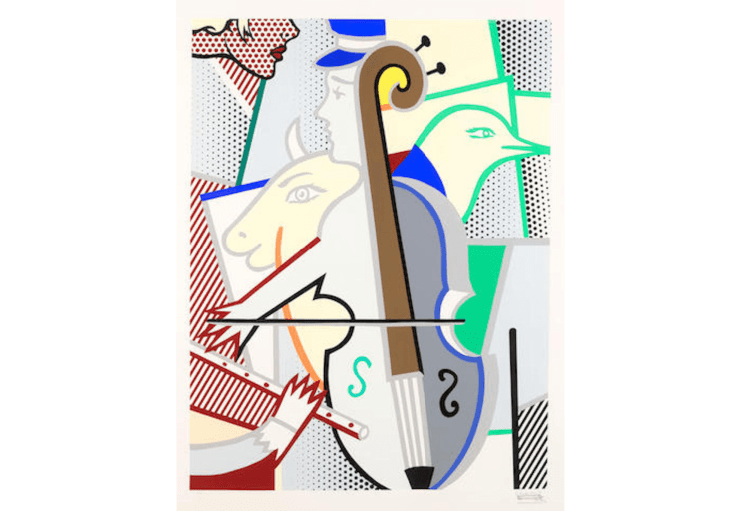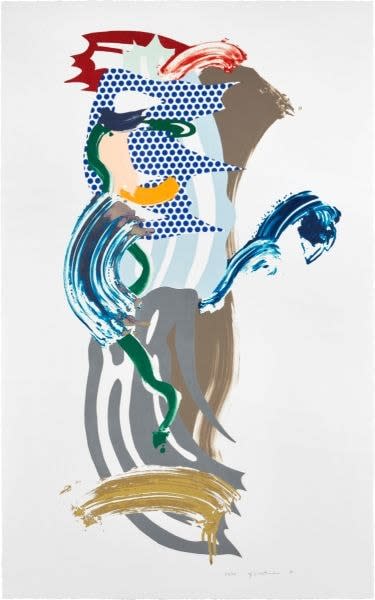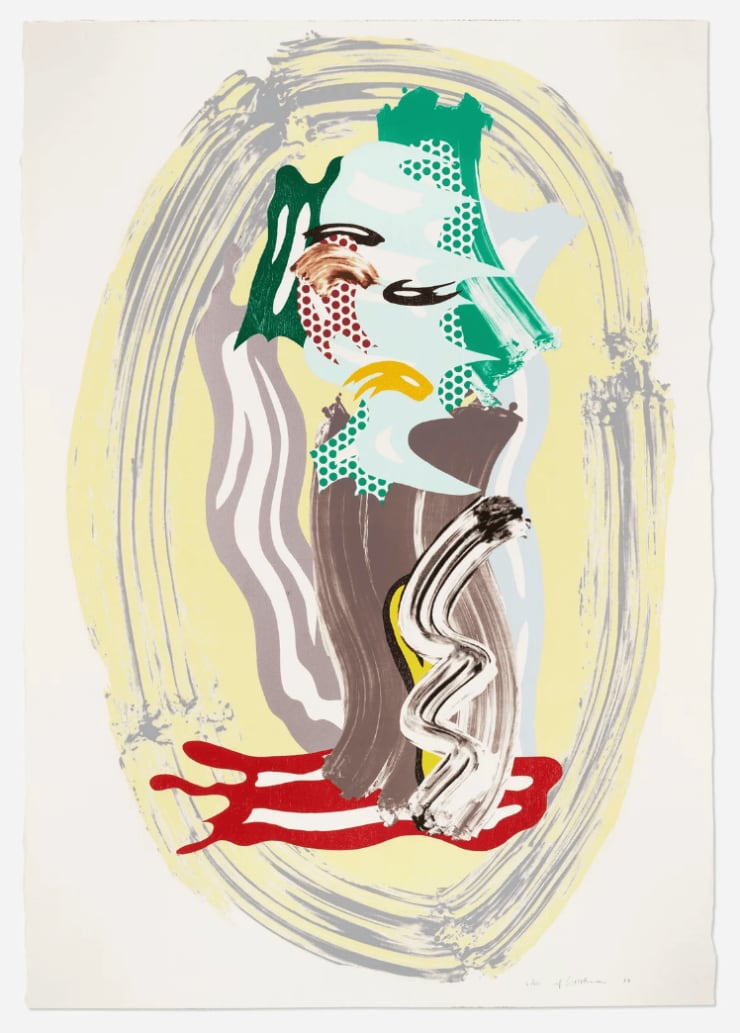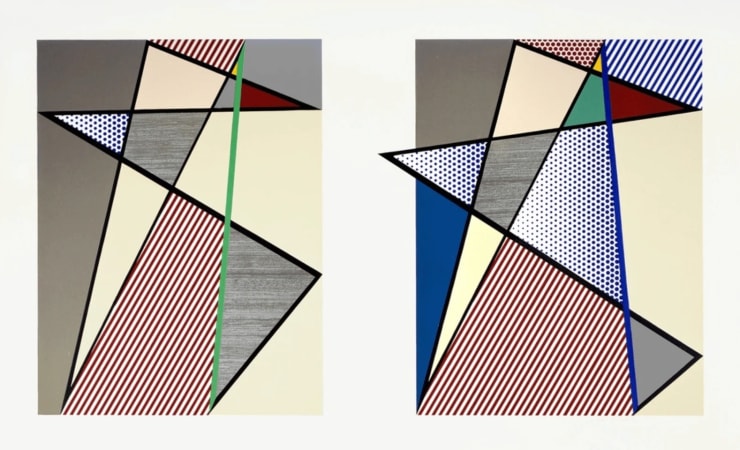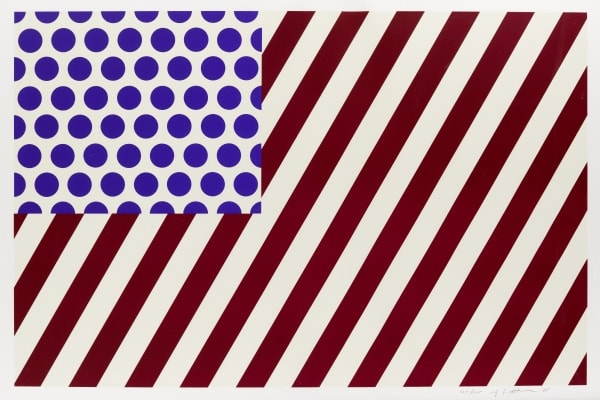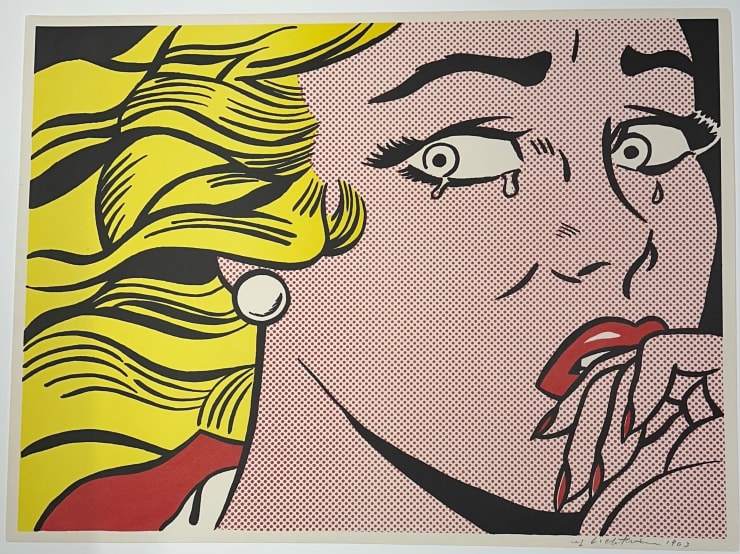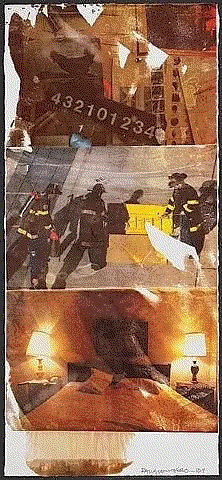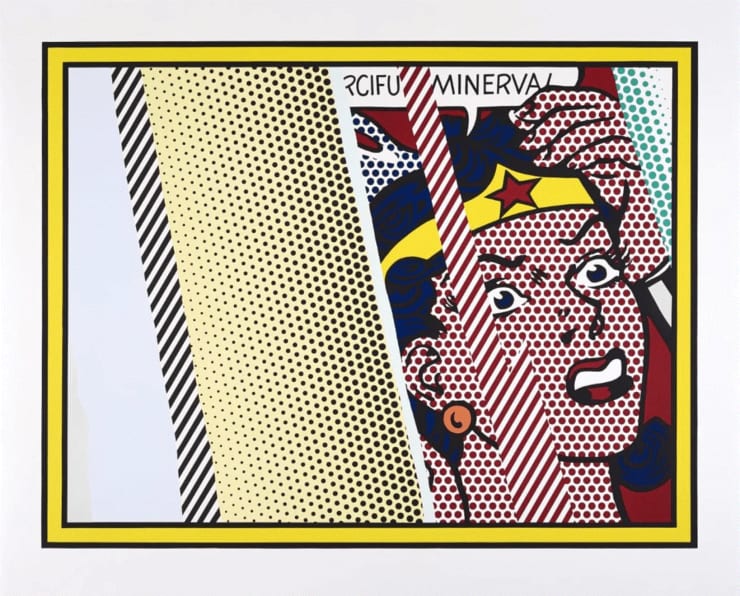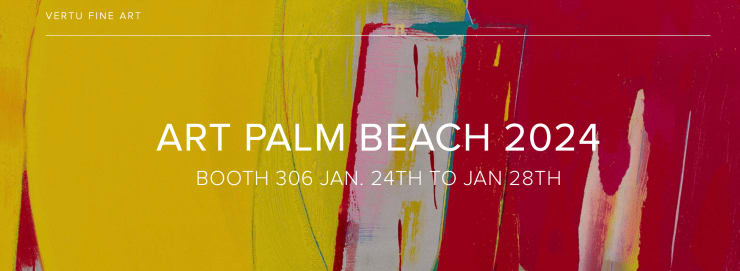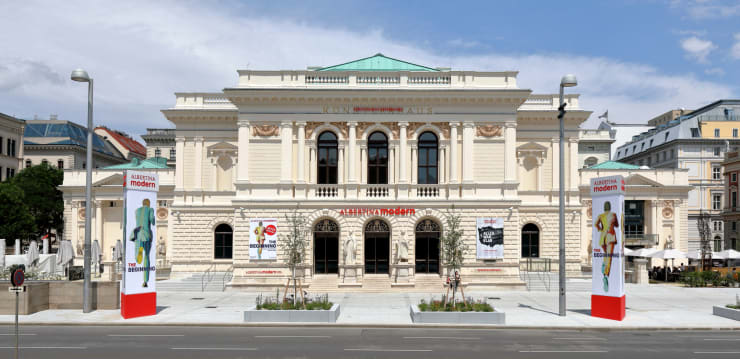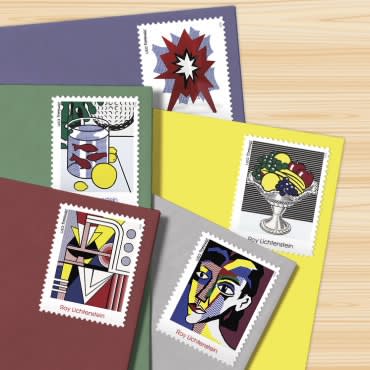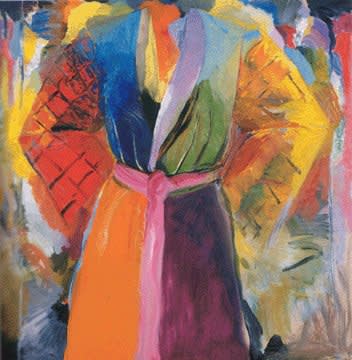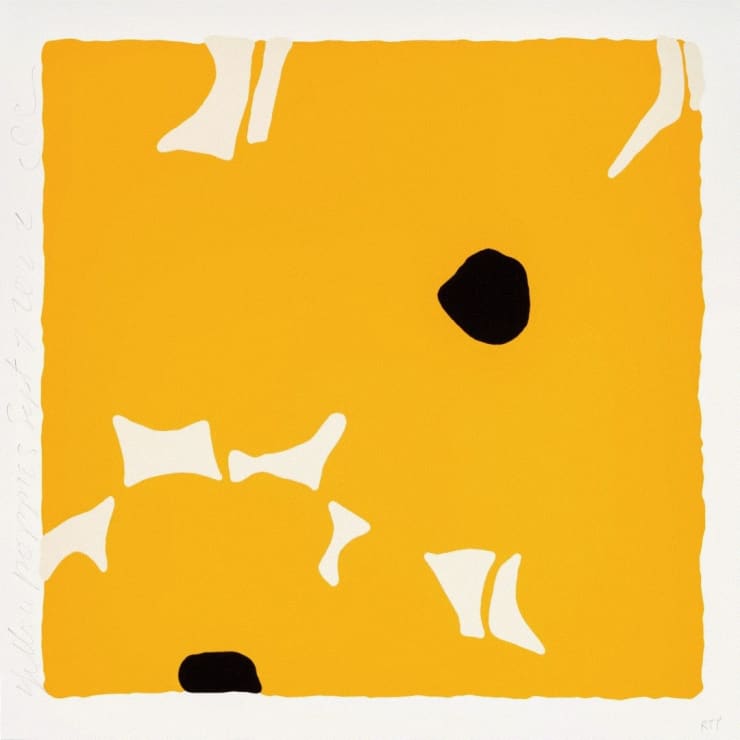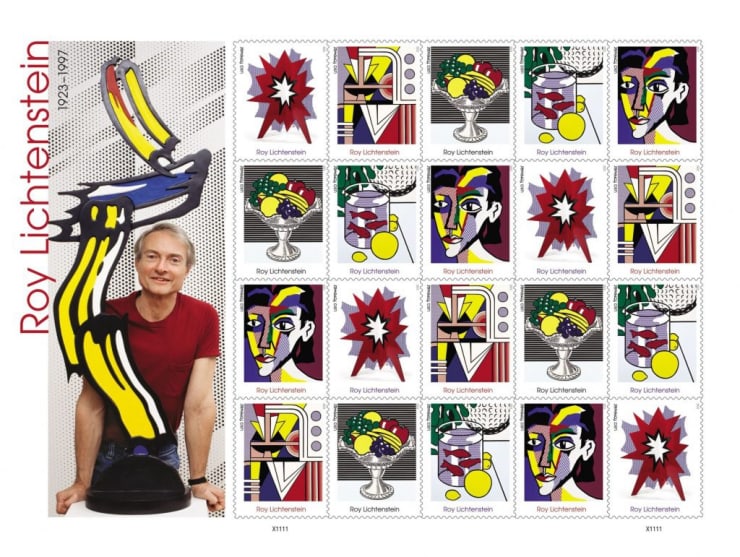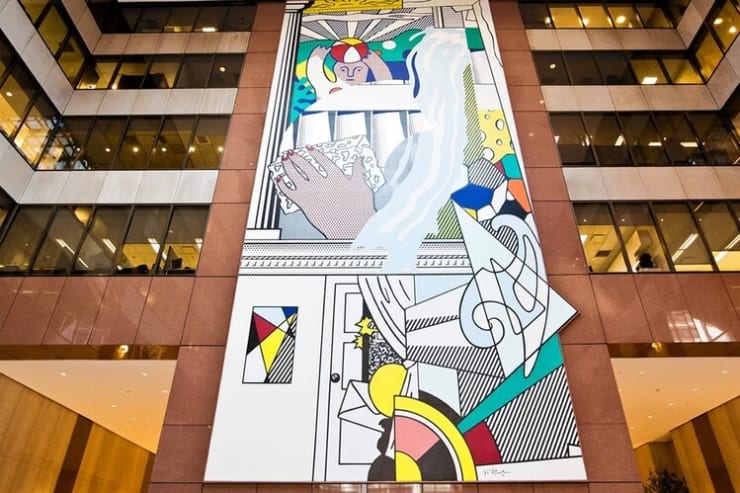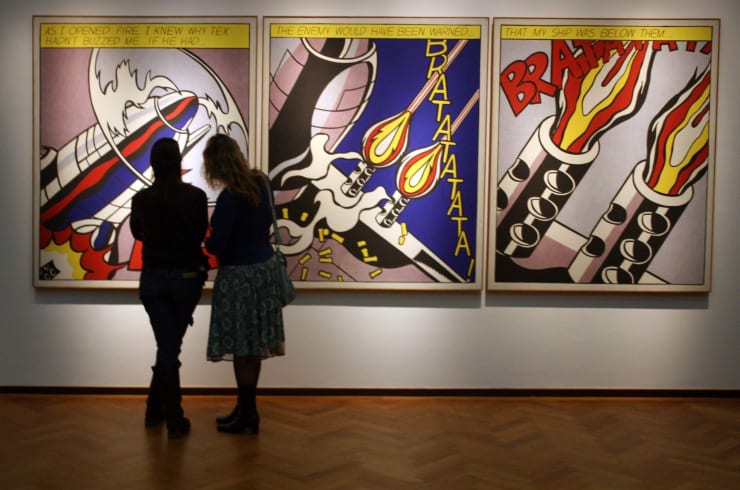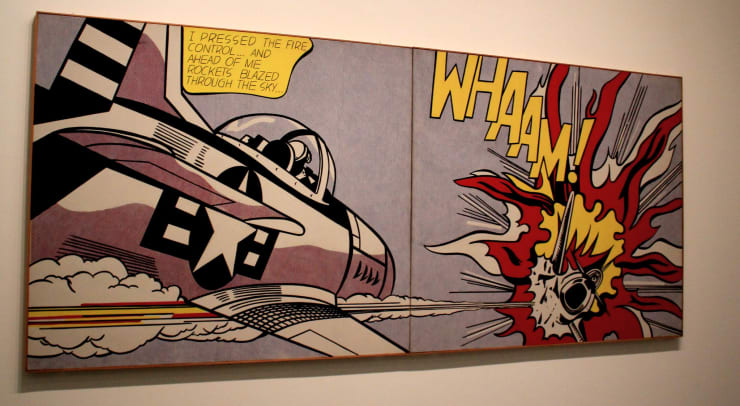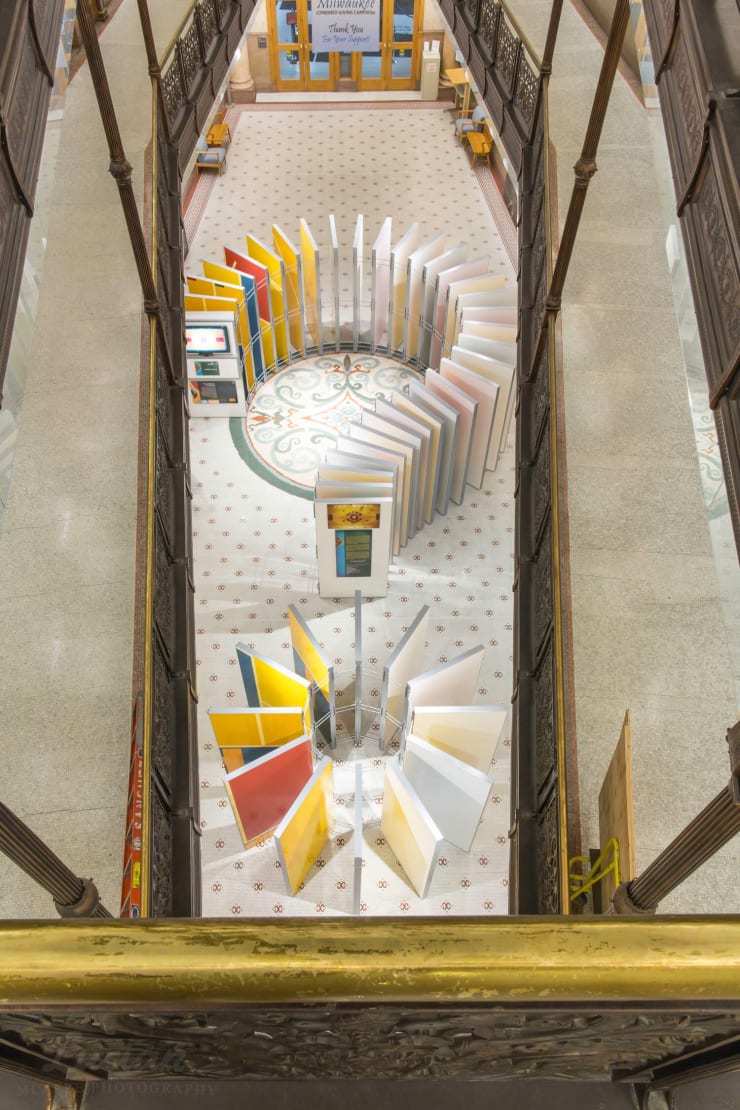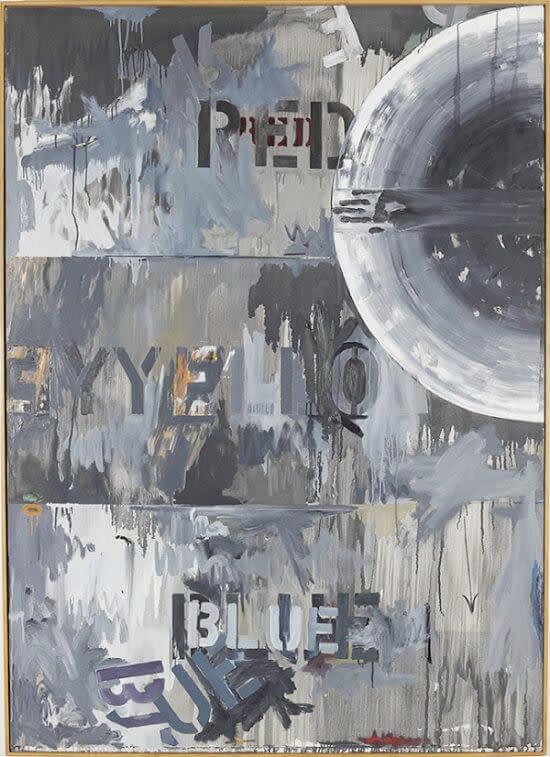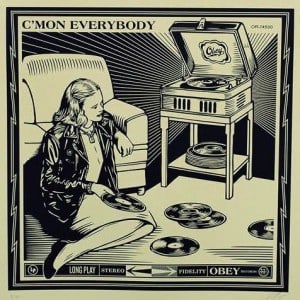Roy Lichtenstein
-
 Roy LichtensteinCubist Cello, 1997Original screenprint in colors on Somerset paper51 × 39 1/2 inEdition of 75Hand-signed and dated by Dorothy Lichtenstein with the estate stamp
Roy LichtensteinCubist Cello, 1997Original screenprint in colors on Somerset paper51 × 39 1/2 inEdition of 75Hand-signed and dated by Dorothy Lichtenstein with the estate stamp -
 Roy LichtensteinReflections on Minerva (c.244), 1990Lithograph, Screenprint, and 3D collage on paper42 x 51 3/4 in
Roy LichtensteinReflections on Minerva (c.244), 1990Lithograph, Screenprint, and 3D collage on paper42 x 51 3/4 in
106.7 x 131.4 cmEdition of 64/68Signed, Numbered, and Dated -
 roy LichtensteinBlue Face from the Brushstroke Figures Series , 1989Lithograph, waxtype woodcut and screenprint on 638-g/m cold-pressed Saunders Waterford Paper54 x 33 1/2 in
roy LichtensteinBlue Face from the Brushstroke Figures Series , 1989Lithograph, waxtype woodcut and screenprint on 638-g/m cold-pressed Saunders Waterford Paper54 x 33 1/2 in
137.2 x 85.1 cm54/60Signed numbered and dated in pencil -
 Roy LichtensteinGreen Face, 1989Color lithograph, waxtype, woodcut, and screenprint on cold-pressed Saunders Waterford paper59 x 41 in
Roy LichtensteinGreen Face, 1989Color lithograph, waxtype, woodcut, and screenprint on cold-pressed Saunders Waterford paper59 x 41 in
149.9 x 104.1 cmPP.IISigned, dated, and numbered in pencil -
 Roy LichtensteinImperfect Diptych ( Corlett 225), 1988Woodcut, screenprint, and collage on Archivart 4- ply Museum Board57 7/8 x 93 5/8 ins 147.2 x 238.1 cm8/45Numbered, signed (rF Lichtenstein) and dated (88) in pencil. Lower right Blindstamp, l
Roy LichtensteinImperfect Diptych ( Corlett 225), 1988Woodcut, screenprint, and collage on Archivart 4- ply Museum Board57 7/8 x 93 5/8 ins 147.2 x 238.1 cm8/45Numbered, signed (rF Lichtenstein) and dated (88) in pencil. Lower right Blindstamp, l -
 Roy LichtensteinImperfect Diptych (C. 225), 198821 color woodcut, screen print, and collage57 7/8 x 93 3/4 in
Roy LichtensteinImperfect Diptych (C. 225), 198821 color woodcut, screen print, and collage57 7/8 x 93 3/4 in
147 x 238.1 cm8/45Signed numbered and Dated by the artist -
 Roy LichtensteinForms in space (Corlett 217), 1985Screenprint on Rives BFK Paper35 3/4 x 52 in
Roy LichtensteinForms in space (Corlett 217), 1985Screenprint on Rives BFK Paper35 3/4 x 52 in
90.8 x 132.1 cm125/125Signed, dated and numbered in pencil -
 Roy LichtensteinPainting on Blue and Yellow Wall ( corlett 208), 1984Woodcut, lithograph on Arches 88 Paper47 1/4 x 31 5/8 in
Roy LichtensteinPainting on Blue and Yellow Wall ( corlett 208), 1984Woodcut, lithograph on Arches 88 Paper47 1/4 x 31 5/8 in
119.9 x 80.3 cm43/60Signed, dated and Numbered -
 Roy LichtensteinI Love Liberty, 1982Screenprint on Arches 88 paper38 2/8 x 27 1/8 ins 97.47 x 68.9 cm
Roy LichtensteinI Love Liberty, 1982Screenprint on Arches 88 paper38 2/8 x 27 1/8 ins 97.47 x 68.9 cm -
 Roy LichtensteinModern print (Corlett 103), 1971Lithograph and screenprint on special arjomari Paperheight 31 in
Roy LichtensteinModern print (Corlett 103), 1971Lithograph and screenprint on special arjomari Paperheight 31 in
height 78.7 cm200Signed and Numbered -
 Roy LichtensteinCrying Girl (Corlett II.1 ), 1963Offset Lithograph on light weight off white Wove Paper18 x 24 in
Roy LichtensteinCrying Girl (Corlett II.1 ), 1963Offset Lithograph on light weight off white Wove Paper18 x 24 in
45.7 x 61 cmHand signed in pencil lower right.
Roy Lichtenstein
There were countless facets to the pop culture movement during the 1960s beyond the iconic pieces of Andy Warhol and many other well-known artists. In fact, there was a particular artist who loved the movement so much that he brought elements from comic books and other aspects of popular culture in order to create highly colorful and thought provoking, tongue-in-cheek pieces of artwork. Born in New York City on October 27th, 1923, Roy Lichtenstein would make it acceptable to consider comic book coloring, shading, and other elements legitimate art.
This affinity with the pop art movement and the style he became so well-known for began at an early age. Lichtenstein was always interested in comic books, science, and otherwise kept to himself with such hobbies. However, during his teenaged years, he started to develop an interest in the creation of the artwork within the comic books and started to learn how to paint. Lichtenstein would eventually attend Ohio State University but was suddenly drafted into World War II and wasn’t able to finish his degree.
Lichtenstein never gave up on painting and after his tour was over in the military, he immediately returned to Ohio State University and finished up his Bachelors in the arts. Roy would stay around campus and finish up his Masters and teach art classes at Ohio State University. This didn’t deter him to continue working on his own pieces and creating interesting paintings inspired strongly by great artists such as Pablo Picasso and others. Lichtenstein enjoyed Americana fiction, oftentimes depicting noir drama and the landscape of the west with cowboys throughout the 1950s.
After some time, Rutgers University offered Lichtenstein a teaching position on their campus. He accepted and it was during this time he was first exposed to the pop art movement and everything it brought. It was the 1960s, full of color and expressionism, and Roy took in every bit of pop art that he could. Eventually, this led him to create his own pop art pieces that would become staples in the community for their unique style.
With his rise of popularity came some critics about his particular set of work. Many questioned whether his pop art was legitimate, with Life magazine going as far as titling their interview with him, “Is he the worst artist in America?” Of course, mainstream audiences begged to differ and made him both a national and international pop art icon.
His work has included taking panels from famous DC comics, using Mickey Mouse and Donald Duck’s image. It was all part of his satire on American pop culture, though he still respected the medium in which he drew inspiration from. Lichtenstein would also create pop art sculptures and well over 300 pieces through printmaking, creating pieces that many people still recognize today.
Only a small portion of our Roy Lichtenstein artwork is represented online. Please contact us if you are looking for something special.
-

On Board with Andy Warhol
June 4, 2025It’s been 38 years since Andy Warhol died, at age 58, after undergoing gallbladder surgery. In the years following his death, the interest in his...Read more -

Recent Acquisitions at VFA
We've Moved! May 21, 2025A painting is a kind of love letter to the audience. - Donald Sultan Donald Sultan uses tough textures to create soft, romantic works. He...Read more -

The Good Business of Andy Warhol's Screenprints
Bobby Grossman's Photos of Warhol at VFA May 15, 2025An exhibit at the Andy Warhol Museum explores the artist’s extensive use of screenprinting. Warhol generated thousands of screenprints during his career, both at The...Read more -

Recent Acquisitions: Works by Tom Wesselmann
Picasso Exhibit Curated by Paloma Picasso May 1, 2025Tom Wesselmann (1931-2004) said that he wanted 'to make figurative art as exciting as abstract art.” He succeeded. Wesselmann began his career as a cartoonist...Read more -

New York Celebrating Fine Art Printmaking
March 26, 2025When we see a work of art by an artist whose style we know, we don’t have to look for the signature in the lower...Read more -

VFA at the The Palm Beach Modern + Contemporary Art Fair
Booth C2. Friday, March 21st through Sunday March 23 March 12, 2025The Palm Beach Modern + Contemporary (PBM+C) will open its eight edition with a VIP Preview on Thursday, March 20th, from 5pm - 9pm at...Read more -

Derrick Adams Homage to Tom Wesselmann
Alex Katz: Theater and Dance in Naples December 11, 2024Brooklyn-based artist, Derrick Adams (b.1970) was one of the many artists who showed up for Art Week Miami. During an interview at the Miami Beach...Read more -

VFA at Art Miami 2024
December 4, 2024Art Miami 2024 is on. The energy and excitement of visitors viewing the works of modern and contemporary art from international galleries is exhilarating. Featured...Read more -

VFA at Art Miami 2024
November 26, 2024The 34th Edition of Art Miami is coming up. Art Miami 2024 will be held in the heart of downtown Miami, at One Herald Plaza,...Read more -

Featured & Favorite Artists at VFA
September 3, 2024This past weekend was an exciting one in New York for art enthusiasts. Art on Paper 2024 , was held during Armory Art Week, celebrating...Read more -

VFA at Art on Paper New York 2024
August 27, 2024The tenth annual Art on Paper Fair opens from September 5-8 at Pier 36 in downtown Manhattan. The Art on Paper Fair coincides with The...Read more -

Works by Julian Opie and Henri Matisse at VFA
August 21, 2024So far this year, Julian Opie ’s works have been exhibited in London, Milan, Guangdong, TianJin, Palma de Mallorca, Leon, Boston, Munich and Krakow. Opie’s...Read more -

The Legacy of Dorothy Lichtenstein (1939-2024)
July 16, 2024Dorothy Lichtenstein, Roy Lichtenstein’s widow, died on July 4 at her home in Southampton, New York. The cause of death was reportedly heart failure after...Read more -

Opie, Longo, Katz & More at Hamptons Fine Art Fair, 2024
Attendance expected to reach 10,000 July 10, 2024The Hamptons Fine Art Fair has become the largest cultural event in the Hamptons. About 8,500 guests attended last year’s Fair. This year, attendance is...Read more -

VFA at the Hamptons Fine Art Fair 2024
July 11-14, 2024 July 2, 2024We hope you will join us at the Hamptons Fine Art Fair which runs from July 11-14, 2024. The fair, now in its 18th year,...Read more -

A Richard Serra Sculpture May Be Resurrected in Paris
The Centennial Celebration Continues for Roy Lichtenstein April 18, 2024A 210-ton sculpture by Richard Serra that has been stashed away in an industrial site outside of Paris for many years, may finally be resurrected...Read more -

VFA at the Palm Beach Modern + Contemporary Art Fair
March 20, 2024This weekend’s Palm Beach Modern + Contemporary Art Fair promises to be an exciting event. Our focus, as always, is on those artists whose skill...Read more -

VFA at the Palm Beach Modern and Contemporary Art Fair
March 21-24 at the Palm Beach Convention Center March 14, 2024The Palm Beach Modern and Contemporary Art Fair is being held at the Palm Beach County Convention Center on Friday, March 22 through Sunday, March...Read more -

Recent Acquisitions: Works by Julian Opie, Harland Miller and Other Great Modern and Contemporary Artists
February 28, 2024With his simplified, signature style, Julian Opie (b.1958) has created computer animated figures that grace the streets of many European, Asian and American cities. Like...Read more -

LUNA LUNA in LA; Debbie Carfagno at VFA
January 31, 2024The works of some of the most playful Pop artists of the twentieth century were showcased at the Luna Luna carnival that opened in West...Read more -

Art Palm Beach 2024
January 24, 2024Art Palm Beach 2024 has been exciting to plan and, with more than eighty galleries from around the world exhibiting modern and contemporary art, it...Read more -

VFA at Art Palm Beach 2024
January 18, 2024Art Palm Beach is back! This year’s show will be held from January 24th to 28th at the Palm Beach County Convention Center. We’ll be...Read more -

Helen Frankenthaler and Modern and Contemporary Fine Art Print Artists
January 3, 2024One of the pleasures of focusing on fine art prints at VFA, is seeing the looks on people’s faces when they discover the depth, beauty...Read more -

2023: A Year of Gratitude at VFA
December 27, 2023At VFA the excitement and joy of this holiday season began early in December at Art Miami . It has been a wonderful year; starting...Read more -

VFA: The Excitement of Art Week 2023
December 6, 2023Miami is an exciting city, but everything gets ramped up and even more exciting during Art Week. The art, fashion, design, even the food, seems...Read more -

Yoshitomo Nara and Roy Lichtenstein at Albertina Modern
VFA at Art on Paper September 7, 2023Many people say that these are children but I think these are not children that I paint. Therefore, they are no particular children but for...Read more -

Celebrating Roy Lichtenstein. At Home with Katherine Bernhardt. Julie Curtiss in Hong Kong
August 23, 2023This year is the 100th anniversary of the birth of Roy Lichtenstein (1923-1997). To honor the artist, the Roy Lichtenstein Foundation will be gifting paintings,...Read more -

Jim Dine Examines Jim Dine; Keith Haring's Work at The Broad
VFA at the Hamptons Fine Art Fair This Weekend July 12, 2023I have come to terms with a lot of things, because, when it’s all said and done, there’s really very little one can do about...Read more -

VFA at the Hamptons Fine Art Fair, 2023
July 5, 2023We’re looking forward to another wonderful edition of the Hamptons Fine Art Fair. This year’s Fair begins with a private viewing on Thursday, July 13th...Read more -

Roy Lichtenstein Retrospective Planned at Whitney; Liliana Porter's Retrospective in France
April 26, 2023The United States Post Office and the Whiney Museum are celebrating the 100th Anniversary of Roy Lichtenstein’s birth. On Monday, April 24th, the USPS held...Read more -

The Restoration of Luna Luna, Banksy's Stamp for Ukraine
March 8, 2023In 1987 the Luna Luna amusement park opened in Hamburg, Germany. The park was created by Austrian artist, Andre Heller. His vision was to get...Read more -

Roy Lichtenstein’s Studio Donated to the Whitney, Andy Warhol Heard with A.I.
February 28, 2022Roy Lichtenstein 1923-1997 The Roy Lichtenstein Foundation has donated the artist's former West Village studio to the Whitney Museum. The building will be renovated and...Read more -

Keith Haring, Derrick Adams and Roy Lichtenstein
February 7, 2022Keith Haring was one of the twentieth century's most innovate artists. Haring took inspiration from Pierre Alechinsky, one of Europe's most avant-garde artists. Alechinsky was born in Brussels, but has spent most of his life living, painting and teaching in Paris. At the age of 94, Alechinsky is still very active. A survey of his work was shown at the Museum of Modern Art in 2017 and, in 2018, he was awarded Japan's Praemium Imperiale Art award for his work.Read more -

The Influence and Legacy of Wayne Thiebaud
December 27, 2021Wayne Thiebaud, one of America's most beloved artists, best knows for his luscious paintings of cakes and pies, died at his home in Sacramento on Saturday, December 25th. He was 101 years old.Read more -

Equitable Building Crash
June 11, 2019Last Monday’s calamitous helicopter crash, into the roof of the 54-story Equitable Building on Seventh Avenue in Manhattan, killed the pilot, left wreckage and caused...Read more -

Roy Lichtenstein: Drawing in the Dark
April 17, 2019In 1962, New York gallery owner, Leo Castelli, chose to represent Roy Lichtenstein. He had seen the works of Andy Warhol and James Rosenquist, and considered representing one of them, but it was Lichtenstein who made the cut. The gallery show, which ran from February 10 to March 3, was the first exhibit of Lichtenstein’s comic book paintings, a big change from the Abstract Expressionist paintings, filled with emotional content, that gallery goers had gotten used to seeing. The comic book paintings sold out and made Lichtenstein, at age 39, a legend in the art world.Read more -

Roy Lichtenstein’s Continued Legacy
December 12, 2018Last summer, the Roy Lichtenstein Foundation announced that it was going to shut down and give the remainder of its assets to museums. About 400...Read more -

Robert Indiana: In Miami, Selling MECCA
September 7, 2017The works of Robert Indiana , and many other great mid-twentieth century artists, will be on display at the University of Miami's Lowe Art Museum...Read more -

Andy Warhol Art for Sale
August 1, 2016At Vertu, we aim to promote modern art by collecting a broad range of artworks from modern artists creating artworks in various styles. We enjoy...Read more -

Jasper Johns Prints for Sale
March 23, 2016He's painted a flag so you don't have to think of it as a flag but only as a painting' -Jasper Johns Jasper Johns has...Read more -

Shepard Fairey’s Cautionary Tone Hits All The Low Notes
October 3, 2014A recently acquired Shepard Fairey serigraph , Endless Power , consistently puts smiles on the faces of viewers who appreciate the Pop Artist’s wry sense...Read more -

Shepard Fairey: Dissent Goes Pop
June 23, 2014Before the Internet became mainstream media and Web 2.0 social channels made content sharing an everyday cultural norm, innovative young artists like Shepard Fairey relied on Word of Mouth advertising to launch “viral” campaigns. Like Pop Artist Keith Haring, who took to Manhattan’s subway stations to garner exposure for his early works, Shepard Fairey employed street tactics to plant seeds of inquiry about the nature of his artistic intentions. In 1989, while a student at the Rhode Island School of Design, Fairey stumbled upon viral success with a sticker he designed and disseminated – bearing the likeness of professional wrestler Andre The Giant.Read more -

Left Coast Pop Art: Ed Ruscha
March 12, 2014When most of us think of American Pop Art, we conjure images of the likes of Warhol, Lichtenstein, Haring and the New York Pop Art...Read more -

Keith Haring Art: Pop’s New Wave
June 7, 2013Keith Haring art is near and dear to us at Vertu Fine Art. Haring is an artist’s artist. Like Warhol , Lichtenstein and Johns, Keith...Read more

